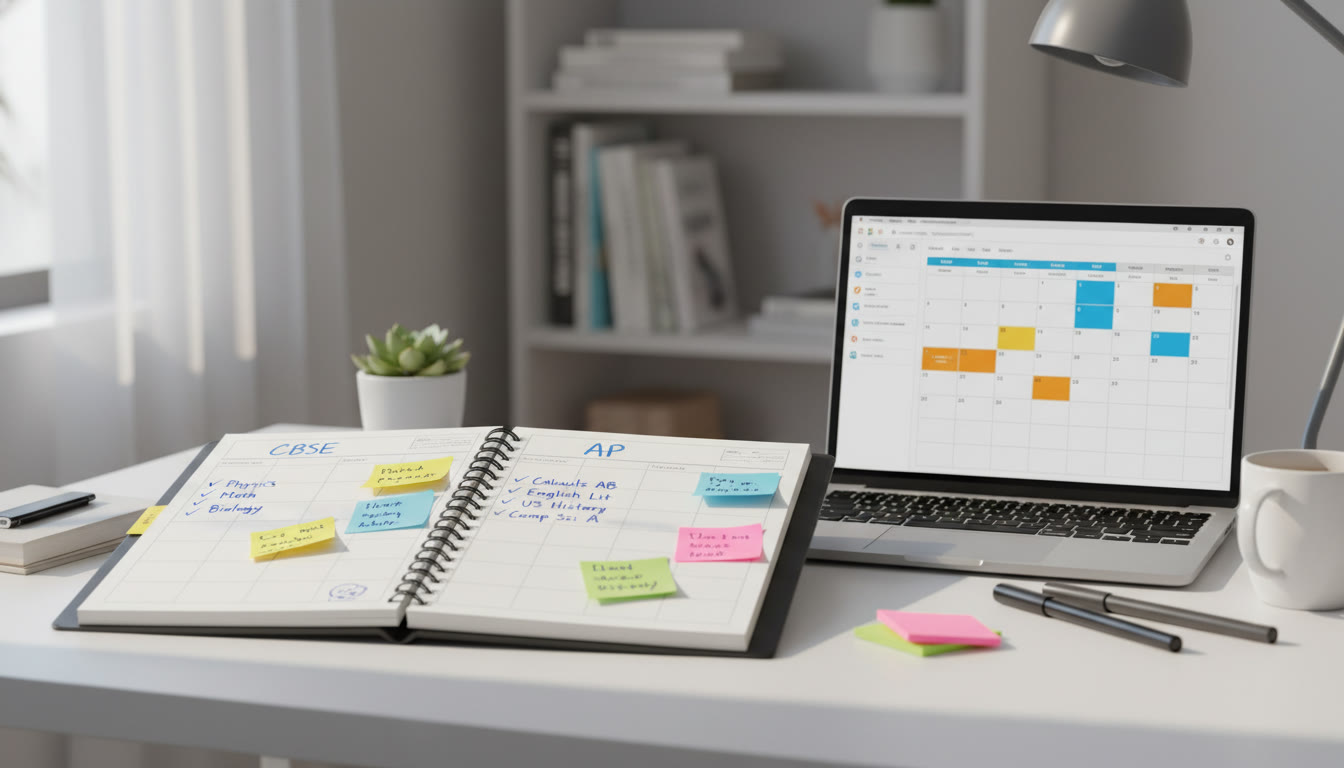Why a combined calendar matters: connecting CBSE rhythms with AP exam months
If you’re a student (or a parent cheering one on) juggling CBSE Class 11–12 coursework and AP preparation, you know the year can feel like a relay race where every lap matters. Creating a single, practical calendar that maps CBSE assessment cycles (unit tests, semestral exams, pre-boards, and board season) alongside AP exam months gives you the confidence to plan study cycles, mock exams, and stress-free rest. This post walks you through a friendly annual roadmap, concrete milestone dates, study strategies, and helpful tools — including how Sparkl’s personalized tutoring can fit naturally into your plan.

At-a-glance: The typical CBSE academic year (Class 11–12) — what to expect
CBSE schools commonly follow a year that starts in April and runs through March the next year, but exact dates can vary by school and state. For Class 11 and 12, the year is usually structured around these major phases:
- Term starts and induction: April–June — class introductions, syllabus mapping, and initial unit assessments.
- Monsoon/First Term assessments: July–September — first round of unit tests and first-semester/half-yearly exams for many schools.
- Second Term and project work: October–December — deeper course work, practicals, and ongoing assessments.
- Pre-board and revision: January–February — intensive revision, pre-boards/mock board exams, and final practicals.
- Board examinations: February–March — official CBSE Class 12 board exams (Class 11 generally follows a similar assessment rhythm but with fewer national-level high-stakes dates).
Keep in mind that many CBSE schools now adopt a two-term system with specific internal assessment windows and project submission deadlines. Talk to your school to pin down exact dates for internal assessments and practicals so you can layer AP prep on top thoughtfully.
Common CBSE checkpoint types (and how to use them)
- Unit Tests: Short, syllabus-specific. Use them as mini-mock AP quizzes when topics overlap (e.g., math/statistics or physics concepts).
- Midterm / Half-yearly Exams: Bigger-picture testing — a great chance to run a full AP-style timed section for stamina training.
- Pre-Board Exams: Dress rehearsals for board exams — schedule full-length AP practice exams in these months to build endurance.
- Practical Exams and Project Submissions: Usually scheduled separately; don’t underestimate the hours they need for practice and finalization.
The AP exam months: when the main action happens
AP Exams are administered each year in May across two primary weeks (a morning session and an afternoon session each day). For example, the two-week AP administration often falls in early–mid May and is the time when most AP students sit the official exams. If you are planning across academic calendars, this means your high-intensity AP revision and testing phase typically peaks in April–May.
How AP timing interacts with CBSE dates
Because CBSE pre-boards and board exams often intensify from January to March, the tightest overlap occurs for students attempting both: pre-boards in February and AP exams in May. That’s a three-month window that’s perfect for focused revision blocks — but it needs strategy to avoid burnout.
Annual combined calendar: month-by-month roadmap (student-friendly)
Below is a practical month-by-month framework you can adapt. The goal is to create predictable rhythms: teach, practice, assess, and recover. This lets both CBSE and AP goals progress together without one cannibalizing the other.
| Month | CBSE Focus | AP Focus | Action Items |
|---|---|---|---|
| April | New academic year, syllabus overview, labs begin | Course selection confirmation; outline AP study plan | Map syllabus overlap; set quarterly goals; enroll in AP resources; schedule weekly AP practice time |
| May–June | Regular classes; first unit tests; practical demos | Begin serious AP content review; start AP Daily videos / short practice | 2–3 weekly AP concept reviews; tie CBSE practicals to AP lab concepts where relevant |
| July–August | Monsoon term assessments; first-semester tests | Mid-course AP practice tests; identify weak topics | Take one timed AP section per week; weekly problem banks; review mistakes log |
| September–October | Half-yearly exams; project submissions begin | Start in-depth AP question practice and FRQ writing (for essay/AP Lang style) | Schedule timed FRQ practice; peer review sessions; refine study schedule |
| November–December | Second term intensifies; more assessments; internal practicals | AP mock exams; strategy refinement | Run at least two full-length AP practice exams; analyze score patterns |
| January | Pre-board scheduling; revision ramps up | Final AP content review; identify last-minute weaknesses | Use pre-board feedback to find topics needing deeper AP practice; plan March–May intensive |
| February–March | CBSE Board Exams (Class 12) / Class 11 major exams | Low-intensity AP review; keep skills warm | Prioritize board performance; maintain light AP practice (30–60 minutes/day) |
| April | Board exam wrap-up; project clearance | AP final revision, timed practice, and submissions for performance-based APs | Move to AP intensive: full-length practice exams, timed FRQs, complete portfolios (if applicable) |
| May | Wind-down / catch-up for schools | AP Exam administration (early–mid May) | Rest well before exam days; use final checklists; submit digital portfolios per deadlines |
| June–July | Results and admissions-related tasks | Score reporting and college planning | Review scores, plan college applications, request rescoring only if necessary |
Notes on AP administration logistics
AP Exams run over a two-week window in May, with morning and afternoon sessions scheduled on each test day. Digital and portfolio submission deadlines for certain AP courses (for example, AP Seminar, AP Research, AP Computer Science Principles, and AP Art and Design) commonly fall in April or early May. If you’re handling performance tasks or digital submissions, build those deadlines into your April calendar so you don’t have a last-minute scramble.
Practical pointers: daily and weekly rhythms that actually work
Structure beats intensity most weeks. Small, consistent efforts compound. Below are sample rhythms that balance CBSE and AP demands.
Sample weekly schedule (during normal school months)
- Daily (Mon–Fri): 30–60 minutes of AP practice (concept review, 1–2 problems or a short reading).
- Twice a week (evenings or weekends): 60–120 minutes focused on AP past-question practice or FRQ writing.
- Weekend deep-dive: 3–4 hours once a week for a timed AP section or full practice, rotating subjects.
- Recovery: one dedicated no-study evening every week to rest and reset.
Exam-season schedule (pre-boards and April–May AP ramp)
- Daily: 90–180 minutes split between board exam topics and targeted AP practice.
- Weekly: One full-length AP practice exam or full CBSE past paper, alternating weeks.
- Active review: After each practice test, spend at least one equal-time session reviewing mistakes and building a short improvement plan.
How to prioritize when CBSE and AP topics collide
Some subjects have natural overlap (e.g., Physics, Chemistry, Calculus, Statistics, Economics). Use this to your advantage:
- Identify overlap topics on both syllabi and create a shared mini-unit so one study session serves both goals.
- For non-overlapping topics, alternate focus days: CBSE-heavy on one day, AP-heavy the next.
- Use board exam months as your priority for final assessment performance; keep AP practice light but consistent during that period.
Real-world example: Physics student juggling CBSE boards and AP Physics
Riya is preparing for CBSE Class 12 physics practicals and the AP Physics 1 exam in May. She maps out lab work and practical demos for January, uses her pre-board in February as a timed test, and then keeps daily 45-minute AP practice in March–April focusing on free-response practice and conceptual problem sets. When portfolios or digital submissions are required, she completes them in early April so her May calendar is focused on the AP exam itself.
Tools and templates: what to track on your calendar
Make a single master calendar (digital or paper) that includes these items:
- All CBSE internal exam dates, practical dates, and project deadlines.
- AP exam dates in May and any AP Digital Portfolio deadlines in April or earlier.
- Weekly practice blocks and full-length mock exam dates.
- Recovery and social time — yes, they’re part of the plan.
Suggested calendar columns (if you keep a spreadsheet)
- Date
- Event (CBSE internal / CBSE board / AP practice / AP exam / Portfolio due)
- Priority (A/B/C)
- Estimated study hours
- Post-task action (what to review next)
Where Sparkl’s personalized tutoring fits (and why it helps)
Blending two intensive systems (CBSE and AP) benefits enormously from tailored guidance. Personalized tutoring can help you create a high-precision plan instead of a one-size-fits-all schedule. Sparkl’s 1-on-1 tutoring, tailored study plans, expert tutors, and AI-driven insights are a natural fit when you need:
- Customized pacing to match your school’s CBSE calendar and AP milestones.
- Targeted practice sessions that focus only on your weakest topics — saving time and improving scores faster.
- Mock exam strategies and feedback that mirror official AP question styles and CBSE marking schemes.
When pressure mounts in January–May, having a tutor who knows both systems lets you shift effort without sacrificing performance in either domain.
Common pitfalls and how to avoid them
- Over-scheduling: Students cram both CBSE revision and AP practice into long days. Fix: prioritize quality short sessions and rest.
- Ignoring portfolio deadlines: Performance- and portfolio-based AP courses have early deadlines. Fix: complete submissions early — treat them as immovable milestones in April.
- One-size studying: Using the same strategy for CBSE and AP can fail because formats differ. Fix: mix multiple-choice speed drills for AP and structured long-answer practice for CBSE board writing.
Checklist: 8 concrete steps to set up your year right (start now)
- Confirm your CBSE internal and board dates with your school by the start of the academic year.
- Register for AP exams and check the official AP exam administration window for the year.
- Create a master calendar with colored blocks for CBSE, AP, practice tests, and rest days.
- Schedule monthly mock exams for both CBSE and AP-style formats.
- Identify 5 overlapping topics and build shared revision modules around them.
- Reserve April for AP portfolio submissions and full-length practice tests.
- Book a Sparkl tutor session to personalize your April–May ramp and to get targeted FRQ feedback.
- Keep a weekly mistakes log and reassess goals monthly.
Putting it all together: sample two-week intensive plan for April (AP ramp)
This sample is what you might do once CBSE boards are wrapped up and you have one month to sharpen AP readiness.
- Day 1–3: Full-length diagnostic AP exam, error analysis, prioritize three weak topics.
- Day 4–7: Focus blocks on weak topics (2–3 hours/day), daily mini-quizzes, one practice FRQ or long answer each day.
- Day 8: Rest and light review — flashcards and conceptual mapping.
- Day 9–12: Timed section practice, one full scored FRQ set, and a tutor-led review session (great time for Sparkl 1-on-1 feedback).
- Day 13–14: Final full-length practice exam and light recovery to ensure peak performance for May.

Final thoughts: rhythm, realistic goals, and the power of small wins
Balancing CBSE and AP is challenging, but with a clear calendar, prioritized practice, and the right support system, it’s entirely achievable. The calendar is your friend: it turns anxiety into a sequence of manageable tasks. Use school timetable anchors (unit tests, pre-boards, practicals) as inputs when you craft AP practice windows, and protect rest as zealously as you protect study blocks.
If you find scheduling overwhelming or want a custom study plan that accounts for your school’s exact dates, a Sparkl tutor’s 1-on-1 guidance — combined with tailored study plans and AI-driven insights — can help you stay efficient, motivated, and confident. A few focused adjustments now can turn a frantic year into a composed, high-achieving one.
Parting checklist (one more time)
- Pin down school CBSE calendar and AP registration details by early in the academic year.
- Build a master calendar with colored priorities.
- Mix short daily AP practice with weekly deep sessions.
- Protect recovery and sleep — they are non-negotiable performance tools.
- Use targeted help (tutors, mentors, or Sparkl’s personalized services) when you need to accelerate improvement.
Good luck — you’ve got a whole year to turn small, steady efforts into meaningful achievement. Keep your calendar visible, celebrate the small wins, and remember that the right plan plus steady work beats last-minute intensity every time.























No Comments
Leave a comment Cancel